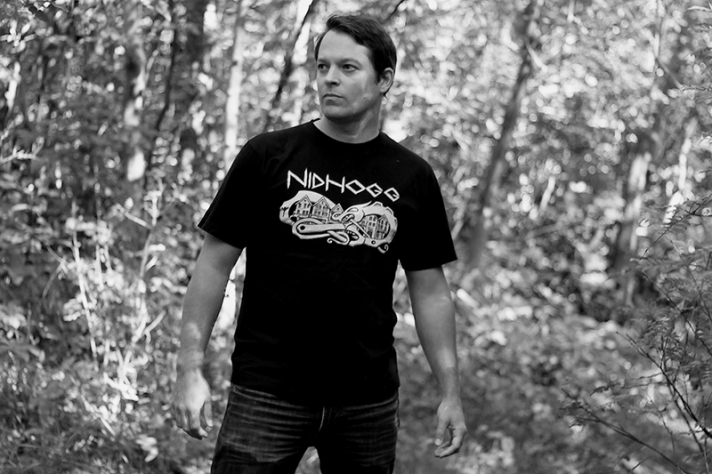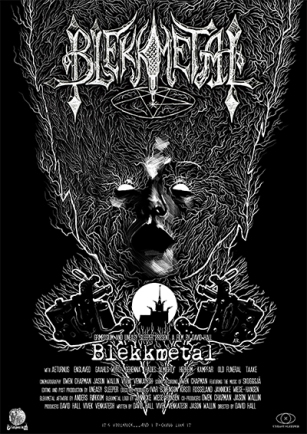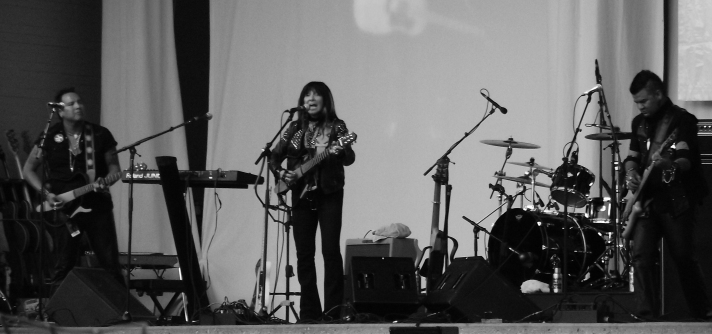Originally posted on UAlberta News.

North of the 60th parallel, surrounded by fjords and nestled between mountains on Norway’s southwestern coast, lies the rain-soaked, freezing-cold city of Bergen. On the harbour sits a massive, old sardine factory that’s found new life as, among other things, a large performance space. Inside, dozens of tattoo artists from around the globe ink patrons who are waiting for the evening’s performances.
In the midst of it is Jason Wallin, a Secondary Education professor from the University of Alberta. He stands out from the crowd with his video camera and boom mike, interviewing attendees about the city and its connection to its most famous musical export–– black metal.
Wallin is part of the four-person, all-Canadian production crew that filmed a documentary about the one-off Blekkmetal Festival in November 2015, which celebrated the origins of black metal music in Bergen. The documentary, Blekkmetal, focuses on the rich histories of Bergen, the music and the people who make up the scene. With its fast, dissonant guitars, harsh vocals and dark lyrics, black metal and its fans have been the subject of much stereotyping–– something Wallin and his colleagues saw on their first day in the city.
“When we got to the Airbnb, the host looked at us and what we were wearing and said ‘Oh, are you here to do a story on Count Grishnackh?’, which is an alias of Varg Vikernes, an avowed neo-Nazi who is infamous for the burning of Norwegian stave churches and for murdering a fellow black metal musician,” Wallin recalls.
“But Blekkmetal wasn’t about rehashing that history. It was more a celebration of an ethic and aesthetic often hidden in orthodox culture. So much of society is predicated on this idea of compulsory happiness, for instance. Black metal takes a more nuanced look at reality through its music and images as to account for a darker image of life.”
Returning to the roots and celebrating the ethic

Although it might seem unconventional for an education professor to play an active role in a documentary about black metal music on the other side of the world, Wallin’s interest in metal isn’t a recent development. Growing up, he developed an ear for the genre through his brother’s love of hair metal like Van Halen and RATT, and power metal like Scorpions. Later, during his graduate studies, Wallin started expanding his musical horizons into other subgenres from doom metal to death and black metal. For Wallin, the music became a way to destress, a pattern he sees in his fellow fans.
“A lot of people say, ‘when I listen to black metal music, it helps to diffuse the all stress that I have’,” says Wallin. “It’s a release because it does it for you. Undergoing the music is a kind of catharsis, for some.”
Eventually Wallin started bringing his interest in metal music and culture into his teaching and research as a faculty member focusing on media and youth culture in curriculum, and through his involvement with Grimposium, a touring metal festival and conference. It was fellow metal studies scholar and Grimposium colleague Vivek Venkatesh who invited Wallin to join the documentary production crew alongside mobile media scholar Owen Chapman and music video director David Hall.
While he had intimate knowledge on the subject matter, making a documentary was new territory for Wallin. With the tight turnaround between the invitation to document the festival and the crew’s departure to Bergen, there wasn’t time for more than a crash course on filmmaking –– Wallin had to sort it out on the fly.
“It’s fortunate that so much can be done in post-production,” jokes Wallin.
“It was amazing because I didn’t know what to do, so I just started doing things. I’ve watched enough film that I think I understand how one might compose a shot. I had so much fun doing it. From my sabbatical year, it was my favourite thing I’ve done, maybe in my career.”
Wallin’s trial-by-fire contributions to the documentary didn’t go unnoticed by his colleagues. Not only does Venkatesh credit Wallin for being a “particularly calming presence” during the stress of filming, but he adds that Wallin’s work on Blekkmetal is highlighted every time the film is screened.
“What Jason brought to the table, which was particularly interesting, was the way in which he conducted interviews with attendees of the festival and members of the scene,” explains Venkatesh.
“He took his camera and microphone and pretty much placed it in people’s faces and asked them a series of questions about how their conception of the music was tied to the physical location of the festival–– what the city meant to them and what it meant for black metal. The variety of the responses he got for the first 20 minutes of Blekkmetal set up the film so well and it’s really thanks to Jason’s very unique ability to get people to speak about these issues and get them to open up in a way that they might not normally feel comfortable doing so.”
Capturing the mythos of Bergen
Learning the art of filmmaking wasn’t Wallin’s only lesson while in Bergen. He also gained a deeper understanding of the city, its people and the local black metal culture. While he acknowledges that a documentary crew’s presence inherently complicates the presentation of the subject matter, Wallin suggests that Blekkmetal explores a more human side of black metal.
“Some of the documentary work and articles written about black metal focus on a particular kind of image, focusing on the violence,” says Wallin. “That’s not to say that it’s not there, however one thing that really came out of Blekkmetal was that the people who partake in it, it’s not about that for them. It’s about a connection to a particular kind of aesthetic that does something for them.”
Another aspect the filmmakers investigated was the range of the fan base and the fluidity between genres like black metal, electronica or opera. Wallin recalls visiting the Bergen Symphony and discovering that one the employees who works the rigging was also in a band performing at the festival.
“The scene is much more collaborative in terms of celebrating what is coming out of it than it is about maintaining rigid territories,” says Wallin. “Even people attending weren’t producing the signs of being a ‘metalhead’ or all the stereotypes that come along with that. The scene is much more diverse.”
That diversity extends to the performers as well. Wallin cites Ivar Bjørnson, from the band Enslaved, who does curriculum work in schools on runes, some of which are found in black metal imagery. Bjørnson teaches students about the runes, their meaning and their connection to a place as a way to rehabilitate a type of wisdom that’s been lost. Bringing the knowledge found in black metal to the classroom is also something Wallin strives for in his own research.
“I see black metal, and what it produces, as a conceptual resource for rethinking education because it is so educative, not in a standardized sense,” Wallin explains. “It shapes you and informs the way that you see things, and that’s crucial to how we navigate reality and our ways in the world.”
Wallin says he would like to work on more film projects about black metal and the scene in the future. In the meantime, he hopes that Blekkmetal audiences take home a different perspective on the relationship between Bergen and black metal.
“Bergen is a germinal place for black metal, and why?” says Wallin. “It leads people back to the importance of ecology and how places can inform upon what gets enunciated. And I hope people enjoy the documentary. It’s a spectacle. It’s immense. It’s loud and all these great things about black metal music.”
Blekkmetal will be screened at Metro Cinema on Tuesday December 6, 2016 at 7 p.m. alongside Heavy Metal Parking Lot. Following the screening there will be a Q&A with Wallin.
